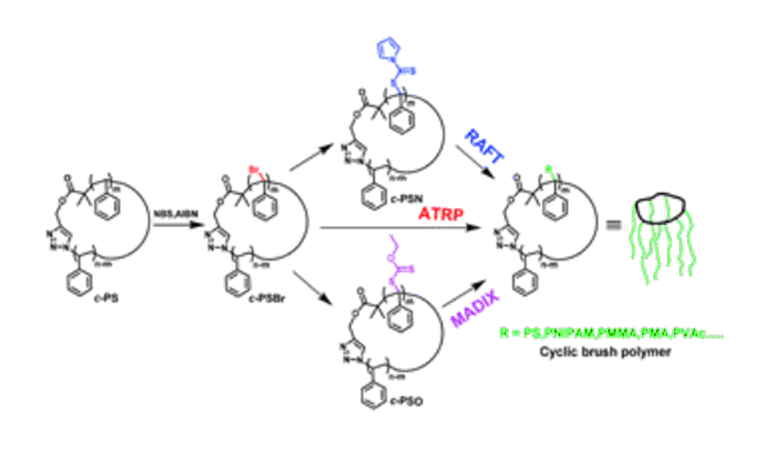Shuangshuang Zhang Lu Yin Wei Zhang Zhengbiao ZhangXiulin Zhu
a State and Local Joint Engineering Laboratory for Novel Functional Polymeric Materials, Jiangsu Key Laboratory of Advanced Functional Polymer Design and Application, College of Chemistry, Chemical Engineering and Materials Science, Soochow University
Polym. Chem., 2016,7, 2112-2120
Combining the ring-closure method with the “grafting from” method, a novel synthetic strategy for preparing cyclic-brush polymers with controlled grafting density was successfully demonstrated. The cyclic polystyrene (c-PS) precursor was synthesized using the general methods of activators generated by electron transfer for atom transfer radical polymerization (AGET-ATRP) and Cu-catalyzed azide–alkyne cycloaddition (CuAAC), and was well characterized using NMR, GPC, MALDI-TOF mass spectroscopy and FT-IR. The benzylic hydrogen atoms of c-PS were substituted with bromine based on Wohl–Ziegler bromination to generate a tertiary bromide ATRP macroinitiator (c-PSBr), and the bromine content can be adjusted to 18.4%, 25.3%, 31.9% and 50.3% by using different reaction conditions. This ATRP macroinitiator can also be converted into a macro-RAFT agent with azole (c-PSN) or ethyoxyl (c-PSO) as the Z groups based on the styrenic polymers as the R group. Using the as-prepared ATRP macroinitiator or macro-RAFT agents, a series of cyclic-brush polymers including c-PS-g-PS, c-PS-g-PNIPAM, c-PS-g-PMMA, c-PS-g-PMA and c-PS-g-PVAc were successfully prepared. The grafting density can be facilely tuned by using variable Br content of c-PSBr or Z group content of the macro-RAFT agents. The work illustrated a first example of versatile synthesis of cyclic-brush polymers with predictable molecular weight, grafting density and different grafting polymer chains.

链接://pubs.rsc.org/en/content/articlelanding/2016/py/c6py00012f